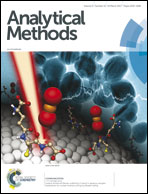Development of competitive indirect ELISAs with a flexible working range for the simple quantification of melatonin in medicinal foods†
Abstract
Melatonin (MT) is an endogenous hormone that is used in medicinal foods for all kinds of purposes. Monitoring the content of MT is necessary to guarantee the quality of medicinal foods, as well as to prevent it from being abused. In this work, an easy-to-use and low-cost competitive indirect ELISA with a flexible working range for monitoring MT was developed. Four haptens were synthesized and coupled to carrier proteins as immunogens to compare their ability to generate antibodies against MT. After screening the antisera and optimizing the working conditions, a homologous ELISA with a limit of detection (LOD) of 30.85 ng mL−1 and a wide working range from 66.2 ng mL−1 to 65.9 μg mL−1, and a heterologous ELISA with an LOD of 0.21 ng mL−1 and a working range from 1.0 ng mL−1 to 104.4 ng mL−1 for MT were developed. Using the homologous format, the developed ELISA is easy-to-use for the quantitative determination of MT in a medicinal food matrix, with the recovery ranging from 84% to 113.6%. Good correlation between the results of the ELISA and standard liquid chromatography (LC) was obtained. The proposed two ELISA formats are ideal tools for screening a large number of medicinal food samples for MT prior to standard instrumental analysis.



 Please wait while we load your content...
Please wait while we load your content...